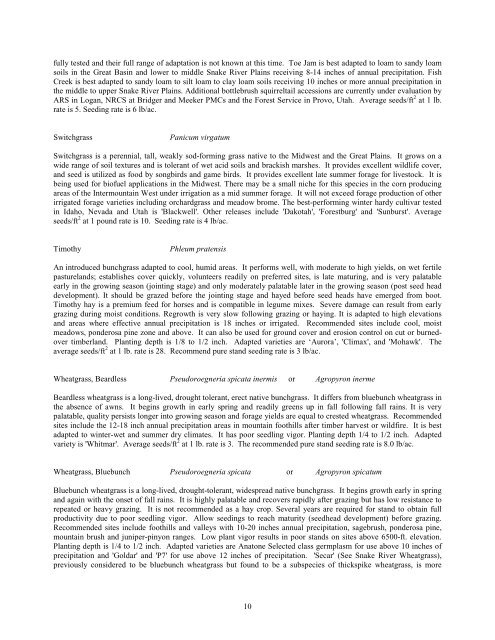Idaho Plant Materials Technical Note No. 24
Idaho Plant Materials Technical Note No. 24
Idaho Plant Materials Technical Note No. 24
You also want an ePaper? Increase the reach of your titles
YUMPU automatically turns print PDFs into web optimized ePapers that Google loves.
fully tested and their full range of adaptation is not known at this time. Toe Jam is best adapted to loam to sandy loam<br />
soils in the Great Basin and lower to middle Snake River Plains receiving 8-14 inches of annual precipitation. Fish<br />
Creek is best adapted to sandy loam to silt loam to clay loam soils receiving 10 inches or more annual precipitation in<br />
the middle to upper Snake River Plains. Additional bottlebrush squirreltail accessions are currently under evaluation by<br />
ARS in Logan, NRCS at Bridger and Meeker PMCs and the Forest Service in Provo, Utah. Average seeds/ft 2 at 1 lb.<br />
rate is 5. Seeding rate is 6 lb/ac.<br />
Switchgrass<br />
Panicum virgatum<br />
Switchgrass is a perennial, tall, weakly sod-forming grass native to the Midwest and the Great Plains. It grows on a<br />
wide range of soil textures and is tolerant of wet acid soils and brackish marshes. It provides excellent wildlife cover,<br />
and seed is utilized as food by songbirds and game birds. It provides excellent late summer forage for livestock. It is<br />
being used for biofuel applications in the Midwest. There may be a small niche for this species in the corn producing<br />
areas of the Intermountain West under irrigation as a mid summer forage. It will not exceed forage production of other<br />
irrigated forage varieties including orchardgrass and meadow brome. The best-performing winter hardy cultivar tested<br />
in <strong>Idaho</strong>, Nevada and Utah is 'Blackwell'. Other releases include 'Dakotah', 'Forestburg' and 'Sunburst'. Average<br />
seeds/ft 2 at 1 pound rate is 10. Seeding rate is 4 lb/ac.<br />
Timothy<br />
Phleum pratensis<br />
An introduced bunchgrass adapted to cool, humid areas. It performs well, with moderate to high yields, on wet fertile<br />
pasturelands; establishes cover quickly, volunteers readily on preferred sites, is late maturing, and is very palatable<br />
early in the growing season (jointing stage) and only moderately palatable later in the growing season (post seed head<br />
development). It should be grazed before the jointing stage and hayed before seed heads have emerged from boot.<br />
Timothy hay is a premium feed for horses and is compatible in legume mixes. Severe damage can result from early<br />
grazing during moist conditions. Regrowth is very slow following grazing or haying. It is adapted to high elevations<br />
and areas where effective annual precipitation is 18 inches or irrigated. Recommended sites include cool, moist<br />
meadows, ponderosa pine zone and above. It can also be used for ground cover and erosion control on cut or burnedover<br />
timberland. <strong>Plant</strong>ing depth is 1/8 to 1/2 inch. Adapted varieties are ‘Aurora’, 'Climax', and 'Mohawk'. The<br />
average seeds/ft 2 at 1 lb. rate is 28. Recommend pure stand seeding rate is 3 lb/ac.<br />
Wheatgrass, Beardless Pseudoroegneria spicata inermis or Agropyron inerme<br />
Beardless wheatgrass is a long-lived, drought tolerant, erect native bunchgrass. It differs from bluebunch wheatgrass in<br />
the absence of awns. It begins growth in early spring and readily greens up in fall following fall rains. It is very<br />
palatable, quality persists longer into growing season and forage yields are equal to crested wheatgrass. Recommended<br />
sites include the 12-18 inch annual precipitation areas in mountain foothills after timber harvest or wildfire. It is best<br />
adapted to winter-wet and summer dry climates. It has poor seedling vigor. <strong>Plant</strong>ing depth 1/4 to 1/2 inch. Adapted<br />
variety is 'Whitmar'. Average seeds/ft 2 at 1 lb. rate is 3. The recommended pure stand seeding rate is 8.0 lb/ac.<br />
Wheatgrass, Bluebunch Pseudoroegneria spicata or Agropyron spicatum<br />
Bluebunch wheatgrass is a long-lived, drought-tolerant, widespread native bunchgrass. It begins growth early in spring<br />
and again with the onset of fall rains. It is highly palatable and recovers rapidly after grazing but has low resistance to<br />
repeated or heavy grazing. It is not recommended as a hay crop. Several years are required for stand to obtain full<br />
productivity due to poor seedling vigor. Allow seedings to reach maturity (seedhead development) before grazing.<br />
Recommended sites include foothills and valleys with 10-20 inches annual precipitation, sagebrush, ponderosa pine,<br />
mountain brush and juniper-pinyon ranges. Low plant vigor results in poor stands on sites above 6500-ft. elevation.<br />
<strong>Plant</strong>ing depth is 1/4 to 1/2 inch. Adapted varieties are Anatone Selected class germplasm for use above 10 inches of<br />
precipitation and 'Goldar' and 'P7' for use above 12 inches of precipitation. 'Secar' (See Snake River Wheatgrass),<br />
previously considered to be bluebunch wheatgrass but found to be a subspecies of thickspike wheatgrass, is more<br />
10
















